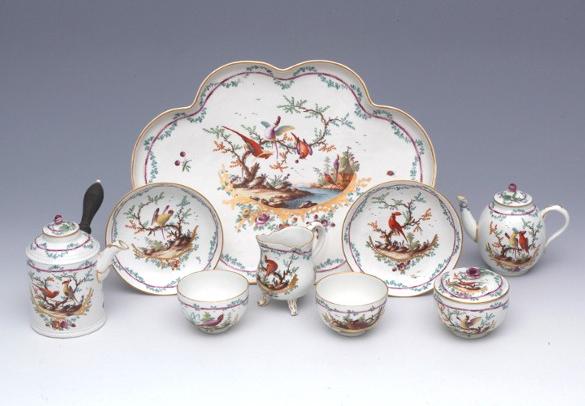Höchst quality and Baroque ornaments
It demonstrates the revival of the old Höchst forms in Damm stoneware in the 19th century and in Passau porcelain during the first half of the 20th century. All Höchst porcelain is displayed, dating from its reestablishment in 1946 to the sample collection of today. Thanks to the donation of Sanofi Aventis Deutschland GmbH and the loan from the Höchst Historical Association as well as other lenders, dressed dining and dessert tables give an insight into the dining culture and living environment of the 18th century. The new presentation on the ground floor of Kronberger Haus deepens the cultural-history aspects of the bourgeois living environment in the 18th century. It demonstrates the ever-changing history of the Höchster Porzellan-Manufaktur from its founding in 1746 to the present day using selected examples of work. Unusual Höchst faience pieces such as the trompe-l'oeil lemon vessel show the degree to which nature served as an orientation in the creation of form and decoration alike.
The Höchst floral paintings were extremely popular. Here we differentiate between the stylised “Indian flowers” in East Asian style and the native “German flowers” painted according to nature, which can be tied into bouquets, designed as series paintings or spread around casually as scattered flowers. Elaborately painted bouquets of flowers can be found on the large, magnificent Höchst “Altbrandenstein” service, which can be admired on a dining table decorated à la française.
The collection of porcelain figures from the stock of former Hoechst AG that Sanofi Aventis Deutschland GmbH donated to us in 2009 is large and precious. Many of the groups back then belonged to dessert pieces such as the “playing boy orchestra” by Laurentius Russinger or the hunting parties, few of which remain intact. The exhibition provides the opportunity to compare the latter with graphic depictions of hunting by Augsburg engraver Johann Elias Ridinger.
Particularly well-represented in the collection of the former Hoechst AG are the figurines by Johann Peter Melchior. The dancing and playing children originate from his early years, captivating us with their direct and natural charm. Melchior created the “Chinese Emperor” around 1765/66 when he was just 18 years old (permanent loan from the Deutsche Stiftung Denkmalschutz). This group is a truly successful masterpiece, with its representative size, balance composition and expressiveness of the figures.
Collection
Kurt Bechtold
Here you will find important works by renowned Höchst modellers and painters arranged by chronological, aesthetic and artistic aspects. The most famous Höchst modellers include Johann Gottfried Becker, Laurentius Russinger and Johann Peter Melchior. Significant painters included Andreas Philipp Oettner, Johann Melchior Schöllhammer, Jacob Melchior Höckel, Peter and Joseph Angele, Friedrich Carl Wohlfahrt, Louis Victor Gerverot and Johann Heinrich Usinger. All artists are represented in the Kurt Bechtold collection.
Floral, purple camaieu, landscape, genre and figure paintings were particularly popular. The different painting styles of each of the Höchst porcelain painters can be studied very vividly, as some of the works have been signed. Artist signatures on porcelain were very rarely seen in the 18th century.
City porcelain collection
Under the artistic direction of renowned Höchst master modeller Johann Peter Melchior, the shape and decoration of the old Höchst porcelain triggered a stylistic change from the playful and bright Rococo shapes to the strict repertoire of forms of Neoclassicism. The valuable luxury items are arranged according to their artistic references, models and presentation. Aspects of cultural history are also included in the exhibition. It shows how practicality can be combined with beauty, as many porcelain items fulfilled their purpose in everyday life – be it on the festively decorated table, during morning grooming, as a room decoration, for private devotion or as sought-after collector’s pieces and gallantries that were given as symbols of friendship and love.
With the change of living habits that accompanied the 17th century, the use of crockery also changed. Through the introduction of three exotic colonial hot beverages (coffee, tea and chocolate), as well as the influences of French and Spanish court etiquette, the drinking and eating habits of the upper aristocratic and bourgeois classes changed fundamentally over the course of the 18th century.

